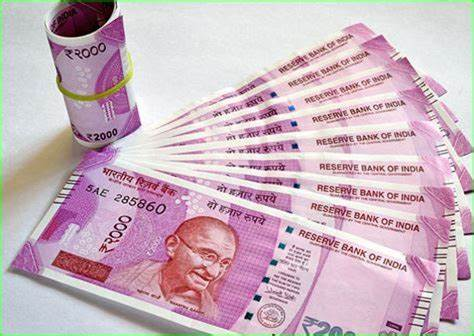Demonetization: 2016 Vs 2023
Important topic for SSB Lecturette
Demonetization is a significant economic policy implemented by governments to combat black money, counterfeit currency, and promote digital transactions. In this article, we will compare the demonetization measures taken by the Indian government in 2016 and the updated situation in 2023, focusing on the withdrawal of Rs 2000 notes. We will analyze the key differences, statistics, and the impact of these actions on the Indian economy.
Demonetization in 2016
In 2016, the Indian government implemented a massive demonetization drive, withdrawing the Rs 500 and Rs 1000 currency notes from circulation. The move aimed to curb corruption, eliminate black money, and promote a cashless economy.
Let's take a look at some key aspects of demonetization in 2016
- Currency Withdrawn: Rs 500 and Rs 1000 notes were withdrawn from circulation, accounting for 86% of the country's currency in value.
- Replacement Currency: The withdrawn notes were replaced with new Rs 500 and Rs 2000 notes, along with the introduction of the new Rs 200 notes.
- Impact on Cash Transactions: The demonetization drive led to a severe cash crunch across the country, causing inconvenience to the general public. Long queues were witnessed outside banks and ATMs as people rushed to exchange their old currency.
- Digital Transactions: The push for a cashless economy saw a significant rise in digital transactions. Online payment platforms and mobile wallets experienced a surge in usage as people turned to alternative payment methods.
- Short-Term Economic Impact: The immediate aftermath of demonetization resulted in a slowdown of the Indian economy. Industries such as agriculture, small-scale businesses, and informal sectors were hit hard due to a lack of liquidity.
- Long-Term Impact: While the short-term impact was challenging, demonetization aimed to have long-term benefits such as increased tax compliance, formalization of the economy, and reduced corruption. The effectiveness of these goals is still a subject of debate.
Demonetization in 2023:
Moving ahead to the current scenario, the Reserve Bank of India (RBI) has recently announced its decision to withdraw the Rs 2000 notes from circulation in 2023. Let's delve into the details and compare the changes with the 2016 demonetization drive:
- Currency Withdrawn: The RBI has decided to withdraw the Rs 2000 notes from circulation, accounting for a significant portion of high-value currency.
- Legal Tender Status: Unlike the 2016 demonetization, the withdrawn Rs 2000 notes will continue to be legal tender. This means that people can still use the existing notes for transactions until September 2023.
- Clean Note Policy: The RBI's decision to withdraw the Rs 2000 notes is part of its clean note policy, which aims to address concerns related to the hoarding of high-denomination currency and the use of counterfeit notes.
- Focus on Digital Payments: The move to withdraw the Rs 2000 notes aligns with the government's continued emphasis on promoting digital transactions and reducing the use of cash. This push towards a digital economy is expected to further increase the adoption of online payment methods.
- Impact on Economy: The long-term impact of the withdrawal of Rs 2000 notes is yet to be seen. However, it is anticipated that the move will lead to a reduction in the circulation of high-denomination currency, potentially affecting black money and counterfeit currency operations.
Recommended reading: UPI's new credit feature will disrupt credit market in India | RBI to lead Credit Market
Pros of Demonetization
| Pros | Explanation |
|---|---|
| Curbing Black Money | Demonetization helps in identifying and curbing black money by bringing unaccounted cash into the formal banking system. It promotes transparency and reduces corruption. |
| Promoting Digital Transactions | Demonetization encourages the adoption of digital payment methods, leading to a reduction in cash transactions. This promotes a cashless economy, increases convenience, and enhances financial inclusion. |
| Counterfeit Currency Reduction | By withdrawing old currency notes and introducing new ones with enhanced security features, demonetization helps in reducing the circulation of counterfeit currency, thus safeguarding the integrity of the monetary system. |
| Formalization of Economy | Demonetization encourages people to move towards formal banking channels, promoting financial inclusion, and expanding the tax base. It aids in better monitoring and regulation of financial transactions. |
Cons of Demonetization
| Cons | Explanation |
|---|---|
| Short-Term Economic Disruption | The sudden withdrawal of currency can lead to a temporary disruption in economic activities, particularly in sectors heavily reliant on cash transactions. This includes small businesses, agriculture, and the informal sector, which may face liquidity issues. |
| Inconvenience to the Public | The process of exchanging old currency notes for new ones during demonetization can cause inconvenience to the general public. Long queues, cash shortages, and limited access to ATMs can disrupt daily life and transactions. |
| Limited Impact on Black Money | Critics argue that demonetization may only have a limited impact on black money as those involved in illegal activities find alternative ways to convert their unaccounted cash into other assets or currencies. The effectiveness of demonetization in curbing black money remains a topic of debate. |
| Cost of Currency Replacement | Introducing new currency notes and phasing out old ones involves significant costs for printing, logistics, and distribution. The government bears these expenses, which can put a strain on public finances. |
Conclusion:
In conclusion, demonetization is a significant economic policy with both positive and negative consequences. It aims to combat black money, promote digital transactions, and reduce counterfeit currency. However, it can lead to short-term economic disruptions, inconvenience to the public, and may have limited impact on black money. The recent withdrawal of Rs 2000 notes in 2023 indicates a continued effort to address concerns related to hoarding and counterfeit notes. Careful analysis of the specific context and implementation is essential to evaluate the outcomes of demonetization while minimizing adverse effects on the economy.




![[FREE PDF] Situation Reaction Test | Psych tests at SSB | 150 SRT Problems](https://blogger.googleusercontent.com/img/b/R29vZ2xl/AVvXsEjVlBQb9_dfKlftvESKgmwROM9daafVjAOJPs1tcMbNdUXoWZz3X9U69okZxsWEu0GoNg02dCTfKvQTszYBUP2WUK8_IFCvgny62AYbxz_Uuc_aLs6mr-_9YdxJaFQJAE0agw_SUlhvRkzMEZGcf0eYghvbIOpxUxjfibBa91tkBHmsWtBqx6Mlx8pB_wY/w72-h72-p-k-no-nu/image.png)
![[FREE PDF] OIR Practice Set - 1 | Officer Intelligence Rating Test](https://blogger.googleusercontent.com/img/b/R29vZ2xl/AVvXsEjLB7ZjV3JgCqyZhJvzDEtDG_1XYECy4Ge17ReprORHqdAqijGsc-oLLfTxjaGljVhVcACM6-aIJtkMCONnHQFvsJp9-ZmIU8FLeZ-9d0X6CwimwY2F33B2BvrYZ3-OoLKmWjG5wPjUqEFi2clNFM8RQMss0aJ2iFN8KJMHcutuVSuNKO_JonjXyRDRttM/w72-h72-p-k-no-nu/Black%20and%20Yellow%20Modern%20Black%20Friday%20Sale%20Mobile%20Banner%20Ad%20(4).png)




![[FREE PDF] Situation Reaction Test | Psych tests at SSB | 150 SRT Problems](https://blogger.googleusercontent.com/img/b/R29vZ2xl/AVvXsEjVlBQb9_dfKlftvESKgmwROM9daafVjAOJPs1tcMbNdUXoWZz3X9U69okZxsWEu0GoNg02dCTfKvQTszYBUP2WUK8_IFCvgny62AYbxz_Uuc_aLs6mr-_9YdxJaFQJAE0agw_SUlhvRkzMEZGcf0eYghvbIOpxUxjfibBa91tkBHmsWtBqx6Mlx8pB_wY/w100/image.png)
![[FREE PDF] OIR Practice Set - 1 | Officer Intelligence Rating Test](https://blogger.googleusercontent.com/img/b/R29vZ2xl/AVvXsEjLB7ZjV3JgCqyZhJvzDEtDG_1XYECy4Ge17ReprORHqdAqijGsc-oLLfTxjaGljVhVcACM6-aIJtkMCONnHQFvsJp9-ZmIU8FLeZ-9d0X6CwimwY2F33B2BvrYZ3-OoLKmWjG5wPjUqEFi2clNFM8RQMss0aJ2iFN8KJMHcutuVSuNKO_JonjXyRDRttM/w100/Black%20and%20Yellow%20Modern%20Black%20Friday%20Sale%20Mobile%20Banner%20Ad%20(4).png)




0 Comments